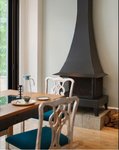What gives us that sense of being truly at home? It's different for each of us.
This item is available in full to subscribers.
We have recently launched a new and improved website. To continue reading, you will need to either log into your subscriber account, or purchase a new subscription.
If you are a digital subscriber with an active subscription, then you already have an account here. Just reset your password if you've not yet logged in to your account on this new site.
If you are a current print subscriber, you can set up a free website account by clicking here.
Otherwise, click here to view your options for subscribing.
Please log in to continue |



We all know it when we see it. It’s that inexplicable sense of comfort that the Danish call hygge – the thing that gives us the sense of being truly at home.
Is it the interior shape of a structure? The way sunlight moves through a room? Could it just be the smell of cut grass or clean linens?
While my experience growing up in historic Germantown shaped my sense of style, it came to me late in my professional career as a restaurateur in the Hudson Valley that what I really love to do is create welcoming spaces. The day-to-day drugerery of running a restaurant started to wear thin after sixteen years. (This epiphany came to me while I was rummaging through our dumpster for a customer in an effort to find their child’s retainer.)
While we had great food, I believe it was the style of the restaurant that kept our loyal New York clientele waiting for tables year after year. When the restaurant interiors became a full-page feature in the New York Times Travel section I was ready to jump into what I now knew I really wanted to do.
So it was this instinct for creating home that led me to my second career, back here in Philadelphia, where I now own and operate an architecture and interior design studio.
I want to kick off this column by inviting you into my home, and sharing just one element of the house I love.
Our East Falls house was once a rectory for the adjacent United Methodist Church. In 2010, my husband and I took on both properties, each of which needed extensive work. Now, 12 years later, the former church contains creative co-working spaces as well as my design studio. The rectory is my home.
The house was in total disrepair, so we had to take all the walls down to the studs – this gave us the opportunity to reconfigure the entire structure. And while there are many things I love about this renovation, one of my favorite design elements is the custom kitchen island with its counter-to-ceiling pot rack.
As a designer, I know that pot racks are like cilantro. People either love them or they hate them.
For my family, this particular pot rack makes the house feel like a home. And that’s not just because of how it looks, but because of how we use it. Perhaps it is due to my restaurateur past, or maybe it’s just because I love working in busy kitchens – but I like to be able to see and grab what I need while cooking. For us, the pot rack is highly functional storage that also provides a casual vibe that I find warm and welcoming.
The key here is that this design element is what works for me. This is the kind of space that makes me feel welcome. And as a designer, my goal is to help others find the design elements that do the same for them. It's not my job to tell you what makes you feel at home. Rather, it’s to help you discover that for yourself.
That is my goal for this column. I’ll be contributing regularly to the Local with my thoughts and experience about what’s worked for others, and how you can make it work for you.
Val Nehez is the owner and principal designer at Studio IQL in East Falls (StudioIQL.com). For more images of the church and the rectory, go to Instagram Studio_iql and quickandlovely_design.